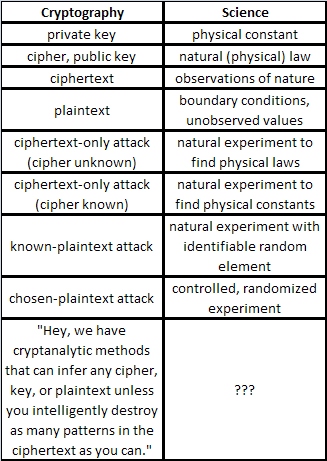Short version: Why can't cryptanalysis methods be carried over to science, which looks like a trivial problem by comparison, since nature doesn't intelligently remove patterns from our observations? Or are these methods already carried over?
Long version: Okay, I was going to spell this all out with a lot of text, but it started ballooning, so I'm just going to put it in chart form.
Here is what I see as the mapping from cryptography to science (or epistemology in general). I want to know what goes in the "???" spot, and why it hasn't been used for any natural phenomenon less complex than the most complex broken cipher. (Sorry, couldn't figure out how to center it.)

EDIT: Removed "(cipher known)" requirement on 2nd- and 3rd-to-last rows because the scientific analog can be searching for either natural laws or constants.